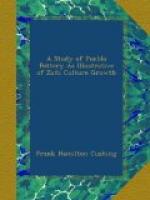Before discussing the origin of other forms, it may be well to consider briefly some influences, more or less local, which, in addition to the general effect of gourd-forms in suggesting basket-types and of the latter in shaping earthenware, had considerable bearing on the development of ceramic art in the Southwest, pushing it to higher degrees of perfection and diversity in some parts than in others.
Perhaps first in importance among these influences was the mineral character of a locality. Where clay occurred of a fine tough texture, easily mined and manipulated, the work in terra cotta became proportionately more elaborate in variety and finer in quality. There are to be found about the sites of some ancient pueblos, potsherds incredibly abundant and indicating great advancement in decorative art, while near others, architecturally similar, even where evidence of ethnic connection is not wanting, only coarse, crudely-molded, and painted fragments are discoverable, and these in limited quantity.
An example in point is the ruined pueblo of A’ wat u i or Aguatobi, as it was known to the Spaniards at the time of the conquest, when it was the leading “city of the Province of Tusayan,” now Moki. Over the entire extent of this ruin, and to a considerable distance around it, fragments of the greatest variety in color, shape, size, and finish of ware occur in abundance. In the immediate neighborhood, however, are extensive, readily accessible formations producing several kinds of clay and nearly all the color minerals used in the Pueblo potter’s art. Yet at the greatest ruin on the upper Colorado Chiquito (in an arm of the valley of which river A’ wat u i itself occurs), where the fallen walls betoken equal advancement in the status of the ancient builders and indicate by their vast extent many times the population of A’ wat u i, the potsherds are coarse, irregular in curvature, badly decayed, and exceptionally scarce. In the immediate neighborhood of this ruin, I need not add, clay is of rare occurrence and poor in quality.
A more reliable example is furnished by the farming pueblos of Zuni. At He sho ta tsi nan or Ojo del Pescado, fifteen miles east of Zuni, clays of several varieties and color minerals are abundant. The finest pottery of the tribe is made there in great quantity, while, notwithstanding the facilities for transportation which the Zunis now possess, at the opposite farming town of K’iap kwai na kwin, or Los Ojos Calientes, where clay is scarce and of poor texture, the pottery, although somewhat abundant, is of miserable quality and of bad shape.




